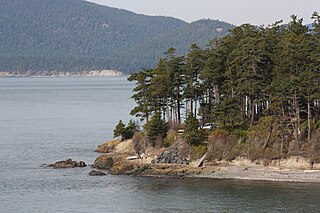
The Douglas fir is an evergreen conifer species in the pine family, Pinaceae. It is native to western North America and is also known as Douglas-fir, Douglas spruce, Oregon pine, and Columbian pine. There are three varieties: coast Douglas-fir, Rocky Mountain Douglas-fir and Mexican Douglas-fir.

Pinus ponderosa, commonly known as the ponderosa pine, bull pine, blackjack pine, western yellow-pine, or filipinus pine, is a very large pine tree species of variable habitat native to mountainous regions of western North America. It is the most widely distributed pine species in North America.

Tsuga mertensiana, known as mountain hemlock, is a species of hemlock native to the west coast of North America, found between Southcentral Alaska and south-central California.

The Northern California coastal forests are a temperate coniferous forests ecoregion of coastal Northern California and southwestern Oregon.

Rubus leucodermis, also called whitebark raspberry, blackcap raspberry, or blue raspberry, is a species of Rubus native to western North America.

Holodiscus discolor, commonly known as ocean spray or oceanspray, creambush, or ironwood, is a shrub of western North America.

Purshia tridentata, with the common name bitterbrush, is a shrub in the genus Purshia of the family Rosaceae. It is native to mountainous areas of western North America.

Acer glabrum is a species of maple native to western North America, from southeastern Alaska, British Columbia and western Alberta, east to western Nebraska, and south through Washington, Oregon, Idaho, Montana and Colorado to California, Arizona, Utah, and New Mexico.

Solanum xanti, known commonly as chaparral nightshade, purple nightshade, and San Diego nightshade, is a member of the genus Solanum. It is native to the Western United States in Arizona, California, Nevada, and Oregon, and to northwest Mexico in Baja California.

Salix lasiolepis is a species of willow native to western North America.

Ericameria nauseosa, commonly known as chamisa, rubber rabbitbrush, and gray rabbitbrush, is a shrub in the sunflower family (Aster) found in the arid regions of western North America.

Psorothamnus arborescens is a species of flowering plant in the legume family known by the common name Mojave indigo bush.

Quercus turbinella is a North American species of oak known by the common names shruboak, turbinella oak, shrub live oak, and gray oak. It is native to Arizona, California, New Mexico, Utah, Colorado, and Nevada in the western United States. It also occurs in northern Mexico.

Physocarpus malvaceus is a species of flowering plant in the rose family known by the common name mallow ninebark. It is native to western North America.

Purshia glandulosa is a species of flowering plant in the rose family known by the common names antelope bitterbrush, desert bitterbrush, Mojave antelope brush, and cliff-rose.

Pseudotsuga menziesii var. menziesii, commonly known as Coast Douglas-fir, Pacific Douglas-fir, Oregon pine, or Douglas spruce, is an evergreen conifer native to western North America from west-central British Columbia, Canada southward to central California, United States. In Oregon and Washington its range is continuous from the Cascades crest west to the Pacific Coast Ranges and Pacific Ocean. In California, it is found in the Klamath and California Coast Ranges as far south as the Santa Lucia Mountains with a small stand as far south as the Purisima Hills, Santa Barbara County. In the Sierra Nevada it ranges as far south as the Yosemite region. It occurs from near sea level along the coast to 1,800 metres (5,900 ft) in the California Mountains. Further inland, coast Douglas-fir is replaced by Rocky Mountain or interior Douglas-fir. Interior Douglas-fir intergrades with coast Douglas-fir in the Cascades of northern Washington and southern British Columbia.

Symphoricarpos oreophilus is a North American species of flowering plant in the Caprifoliaceae, or honeysuckle family, known by the common name mountain snowberry. It has a wide distribution in western Canada, the United States, and northwestern Mexico. It is found in mountainous areas such as the Cascades, the Sierra Nevada, the Rockies, and the Sierra Madre Occidental from British Columbia to the Copper Canyon region of Chihuahua, from the coastal states as far inland as the Black Hills, the Oklahoma Panhandle, and trans-Pecos Texas.

Aquilegia laramiensis is a species of flowering plant in the buttercup family known by the common name Laramie columbine. It is endemic to Wyoming in the United States, where it is known only from the Laramie Mountains.

Actaea elata is a species of flowering plant in the buttercup family known by the common name tall bugbane. It is native to the Pacific Northwest of North America, where it can be found in British Columbia, Washington, and Oregon.




















